Bees and Their Floral Preferences: A Detailed Exploration
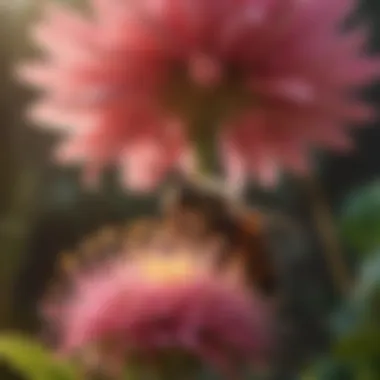
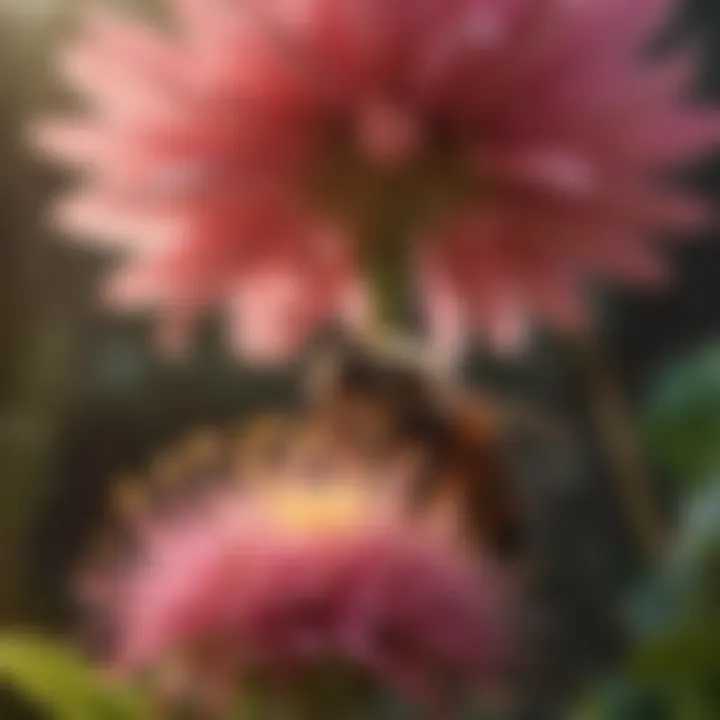
Intro
Bees are remarkable creatures that play a crucial role in our ecosystems. Their intricate relationship with various flowers is fundamental to both their survival and the health of our environment. Understanding the floral preferences of bees is essential for promoting biodiversity and ensuring successful pollination processes. In this exploration, we will examine the characteristics of flowers that attract bees, the implications for pollination ecology, and the interplay between bees and their floral companions. By diving into these aspects, we aim not only to enrich our understanding but also to highlight the significance of these connections for environmental sustainability and conservation efforts.
Key Points of Discussion
This article will address several key areas related to bees and their floral preferences:
- The specific traits of flowers that draw bees in, including color, scent, and shape.
- Geographic considerations that affect the availability of preferred flowers for different bee species.
- Ecological implications of the interactions between bees and flowers, emphasizing the importance of these relationships in broader environmental contexts.
Through a detailed examination, we will provide insights into how bees navigate their floral landscapes, the impact of these interactions on plant reproduction, and the potential consequences for ecosystems if these relationships are disrupted. This information is vital not only for academics and forestry professionals but also for anyone interested in biodiversity and conservation.
Understanding Bee Attraction
Bee attraction is a critical aspect in understanding the broader interactions between flora and fauna. Bees are integral to various ecosystems as they play a vital role in pollination. This relationship not only supports the reproduction of flowering plants but also contributes to the health of entire ecosystems. Given that one-third of the food we consume relies on pollination, the significance of bees cannot be overstated. Therefore, understanding why certain flowers attract these insects is essential for maintaining biodiversity and sustainability.
The Importance of Pollinators
Pollinators, particularly bees, facilitate the reproduction of many plants. This process is crucial for the production of fruits, vegetables, and nuts. Without bees, many crops would experience lower yields or even failure, leading to food shortages and economic loss. Furthermore, bees contribute to ecosystem services by ensuring genetic diversity among plants. This diversity helps ecosystems to adapt to changes and provides habitat and food for other species.
- Nutritional Value: The variety of crops pollinated by bees includes those providing essential nutrients to humans.
- Economic Impact: The economic value of crops dependent on bee pollination is estimated in billions of dollars annually.
- Biodiversity: Bees support a diverse range of plants, which are critical for a balanced ecosystem.
Factors Influencing Floral Preference
The relationship between bees and flowers is influenced by multiple factors that can affect their interactions. These factors can shape which flowers are more appealing to bees and significantly impact floral diversity.
- Color: Bees have a preference for certain colors. Flowers that are bright and colorful tend to attract bees because they correlate with high nectar availability.
- Scent: The fragrance of flowers also plays a crucial role. Certain scents can either attract or repel bees. Flowers that emit strong, sweet fragrances are generally more appealing.
- Nectar and Pollen: The availability and quality of nectar and pollen are perhaps the most significant factors. Flowers rich in these resources will naturally draw in bees seeking nourishment.
- Flowering Time: Seasonal flowering patterns can influence bee attraction. Flowers that bloom during peak bee activity periods are more likely to be visited.
- Habitat: The surrounding environment can affect the presence of particular flower species, which may influence bee preferences.
Understanding these elements assists in designing pollinator-friendly habitats and gardens. By focusing on the preferences of bees, we can better support their populations and, consequently, our own food security.
Characteristics of Bee-Friendly Flowers
The understanding of bee-friendly flower characteristics is crucial for promoting biodiversity and effective pollinator management. Various traits in flowers are specially tailored to attract bee species. By comprehending these aspects, we can design gardens and landscapes that serve not only aesthetic purposes but also ecological benefits.
Specific Elements:
Flowers have unique characteristics that make them more appealing to bees. These traits include their color, fragrance, shape, and the availability of nectar and pollen. Each feature plays a role in guiding bees and facilitating their foraging behaviors. The selection of plants with suitable traits can lead to higher visitation rates from bees, benefiting both the plants and the overall ecosystem.
Benefits:


Implementing bee-friendly flowers leads to enhanced pollination success. Pollination is vital for the reproduction of many plants. By providing flowers that attract bees, gardeners and land managers can create sustainable landscapes that foster thriving bee populations. Additionally, this contributes to greater food production in agricultural systems reliant on pollinators.
Considerations about Characteristics:
When selecting bee-friendly flowers, it becomes essential to consider local bee species and their preferences. Different bees may favor different flower types. For instance, some bees prefer tubular flowers, while others may favor broader blooms. Understanding these nuances leads to more effective gardening and landscaping efforts.
Research indicates that the decline of native bee populations correlates with reduced floral diversity in habitats.
This highlights the importance of selecting a variety of flowers that meet the needs of local bee species.
Color and Visual Cues
Color is one of the primary cues that attract bees. Bees are sensitive to ultraviolet light, a spectrum undetectable to humans. Many flowers reflect UV wavelengths, making them more visible to bees. These visual cues are not only important for attraction but also help bees distinguish between different flower species.
Bees have shown preferences for specific colors. For example, blue and yellow flowers typically attract more bee species compared to other colors. This enhances the selection of flowers in gardens and green spaces, optimizing pollinator visitations.
Fragrance and Scent
Plants often emit scents to attract pollinators, and bees are no exception. Fragrance serves as a chemical cue guiding bees towards their food resources. The presence of certain volatile compounds can signal nectar availability.
Interestingly, not all scents attract bees equally. Some highly fragrant flowers like lavender and honeysuckle are particularly known for their strong allure. A combination of visual appeal and scent increases the likelihood of bee visitation, creating a symbiotic relationship.
Shape and Structure
The morphology of flowers plays a critical role in their ability to attract bees. Specific structural features such as the presence of landing zones can facilitate easier access to nectar and pollen. Flowers with complex shapes may offer better rewards to certain bee species whose anatomy aligns with the flower's structure.
Tubular flowers often benefit long-tongued bees, while shallower flowers are more accessible to short-tongued varieties. Understanding these interactions helps in selecting appropriate plants for various bee species present in any given area.
Nectar and Pollen Availability
Nectar and pollen are fundamental resources for bees. Flowers evolved to produce these substances as rewards for pollinators. Nectar serves as a carbohydrate source, while pollen provides proteins, lipids, and vitamins essential for bee health.
Floral density can influence resource availability. A plant species that produces ample nectar and accessible pollen leads to increased foraging efficiency for bees. It’s beneficial to include multiple flowering species that bloom at different times to ensure continuous resource availability throughout the growing season.
In summary, the characteristics of bee-friendly flowers encompass color, scent, shape, and resource availability. Understanding these attributes is key for conservation efforts, agricultural productivity, and ecosystem health.
Common Flowers that Attract Bees
In this article, we explore the types of flowers that are most appealing to bees. Understanding the common flowers that attract these pollinators is crucial for several reasons. First, it helps in conserving bee populations, which are essential for maintaining biodiversity. Second, it provides insight into the best plants for gardeners and land managers wanting to support their local ecosystems.
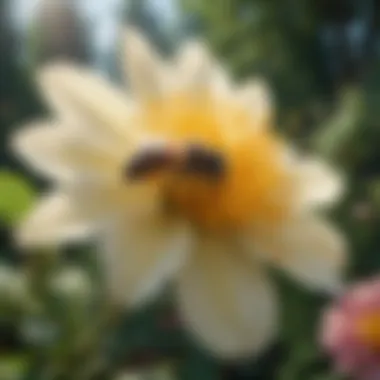
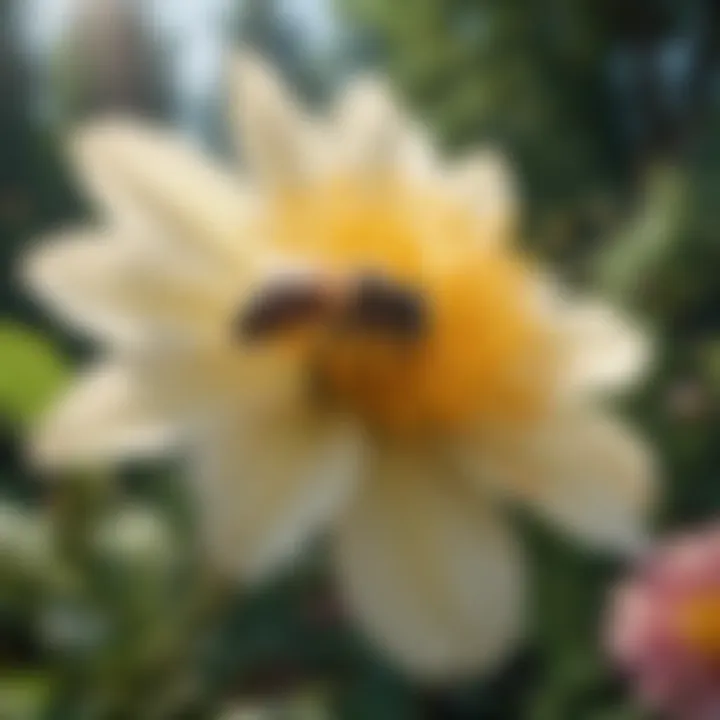
Bees rely heavily on flowers for nectar and pollen. These resources are vital for their survival, reproduction, and overall health. Choosing the right flowers can significantly impact not only the local bee population but also the wider environment.
Wildflowers and Native Plants
Wildflowers and native plants represent a critical source of nutrition for bees. These plants are often well-adapted to local conditions, offering blooms at different times throughout the growing season. Some examples include:
- Coneflower (Echinacea): Known for its bright purple petals, coneflower attracts various bee species.
- Black-eyed Susan (Rudbeckia hirta): This yellow flower is attractive to many pollinators, providing ample pollen.
- Milkweed (Asclepias): Particularly important for monarch butterflies, it also provides nectar for bees.
Planting a diversity of native wildflowers encourages a stronger bee population. This is because they have co-evolved with local bee species, making their traits particularly attractive to these insects. Furthermore, native plants require fewer resources to maintain as they naturally thrive in their local environments.
Cultivated Varieties in Gardens
Cultivated flowers play a significant role in attracting bees to gardens. These are often selected for their ornamental qualities as well as their ability to provide resources for pollinators. Some popular cultivated varieties include:
- Lavender (Lavandula): The strong scent and vibrant color make it a favorite among bees.
- Sunflower (Helianthus annuus): Its large blooms and high pollen production attract a wide range of bee species.
- Zinnias (Zinnia elegans): These colorful garden staples bloom throughout the summer season, providing food for bees.
Selecting cultivated varieties that are known for attracting bees can enhance garden biodiversity. Continuously blooming flowers ensure that there is a consistent food source for these important pollinators.
Herbs and Aromatic Plants
Herbs and aromatic plants are another excellent way to attract bees. Many of these plants not only enhance your culinary endeavors but also provide essential resources for bees. Popular herbs include:
- Basil (Ocimum basilicum): It produces small, attractive flowers that are favored by bees.
- Thyme (Thymus vulgaris): Blooms profusely and offers a rich source of nectar.
- Mint (Mentha): Known for its strong aroma, it attracts various bee species.
Incorporating herbs into gardens can create a more bee-friendly environment. Additionally, many herbs are easy to grow and can be used in a variety of dishes, providing both aesthetic and practical benefits.
Geographic Variations in Floral Preferences
Understanding geographic variations in floral preferences is crucial for recognizing how bees interact with their environment. Different regions present unique ecosystems and plant species that can significantly influence bee behavior. In this section, we will examine the regions with high bee diversity and discuss how climate affects flowering patterns, shaping the floral landscape.
Regions with High Bee Diversity
Regions with rich biodiversity are often havens for bees. Areas such as the Mediterranean, tropical rainforests, and temperate grasslands host a variety of flower species that attract numerous bee types. For instance, the Mediterranean region features many endemic plants that support diverse bee communities. This relationship is not merely incidental; it is a vital link in ecosystem functionality.
- Floral Variety: Diverse vegetation increases nectar and pollen sources.
- Species Adaptation: Different bees have evolved to exploit specific flowers, ensuring a mutualistic relationship thrives.
- Habitat Complexity: Regions with varied habitats allow bees to access various floral resources, promoting health in bee populations.
"Biodiversity within regions enhances the resilience of bee populations, providing essential resources and habitat stability."
Impact of Climate on Flowering Patterns

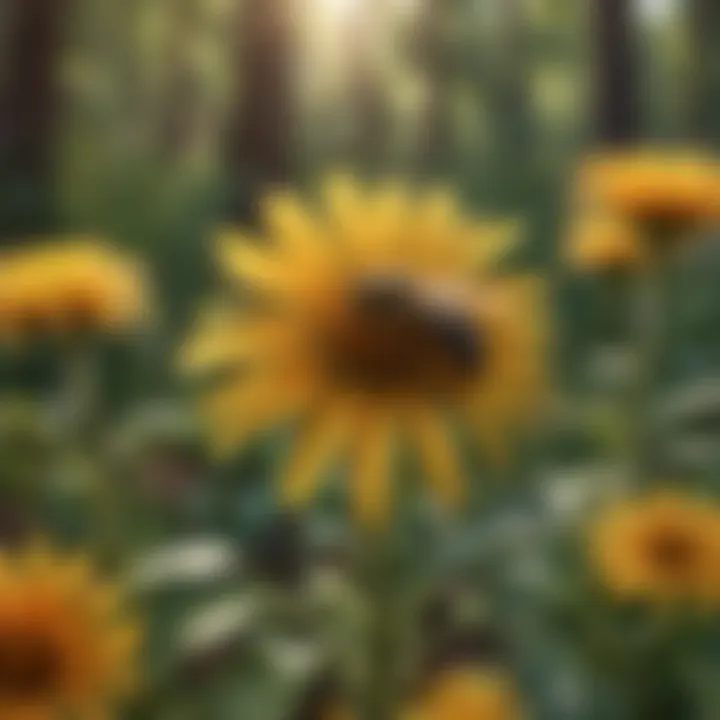
Climate plays a critical role in determining flowering patterns, which in turn affects bee accessibility to flowers. Changes in temperature, precipitation, and seasonal shifts can lead to earlier or delayed flowering times for various plants. It is essential to understand these dynamics for several reasons:
- Timing of Flowering: Climate change can lead to a mismatch between when flowers bloom and when bees are active. This can reduce food availability for bees, impacting their populations.
- Plant Distribution: As climate conditions shift, some plants may become less viable in certain areas, leading to alterations in floral diversity.
- Conservation Considerations: Understanding these climatic influences aids in conservation efforts and allows for better planning and management of bee habitats.
In summary, geographic variations in floral preferences underscore the intricate connections between bees and their environments. Recognizing the factors at play helps us appreciate the complexity of ecosystems and the critical role bees serve within them.
Ecological Implications of Bee-Flower Interactions
Understanding the interplay between bees and flowers is pivotal to grasping wider ecological dynamics. The intricate relationships formed contribute not only to the survival of bee species but also to the overall health of ecosystems. This section delves into the roles that bees play as pollinators and the consequences of their interactions with flowering plants. The complexity of these relationships illustrates their significance in the realms of biodiversity and agricultural sustainability.
Role of Bees in Ecosystems
Bees are often regarded as keystone species due to their essential role in pollination. Pollination is crucial for the reproduction of many flowering plants, which form the foundation of various ecosystems. This process enables the production of fruits, seeds, and nuts that serve as food sources for a multitude of organisms. By facilitating plant reproduction, bees help maintain plant diversity, which is vital for ecosystem resilience.
Furthermore, bees contribute to human agriculture, impacting food security. Crops such as almonds, apples, and berries rely heavily on bee pollination. The economic significance of these crops underpins the importance of preserving bee populations.
Pollinators, including bees, are responsible for 35% of global food production, highlighting their indispensable role in agriculture and biodiversity.
Bees also indirectly influence habitat structure. As they pollinate a diverse array of plant species, they help create environments that support various other wildlife. The interplay of different flowering plants contributes to habitat complexity, providing niches for other species.
Effects of Habitat Loss on Bee Populations
The decline in natural habitats presents a significant threat to bee populations worldwide. Urbanization, agricultural expansion, and land use changes have led to fragmentation of habitats. This limits access to floral resources and disrupts foraging patterns. As a consequence, bee populations may decline, which can destabilize entire ecosystems.
Habitat loss not only affects the availability of food sources but also impacts nesting sites. Many bee species require specific conditions to thrive. For example, solitary bees often nest in undisturbed soil or plant stems. The destruction of natural areas diminishes these critical resources.
Mitigating habitat loss is essential. Planting native flower species and creating bee-friendly environments in urban and agricultural landscapes can offer refuge. Conservation efforts should focus on preserving existing habitats while restoring those that have been lost.
In summary, the ecological implications of bee-flower interactions are profound. They encompass vital processes related to pollination, food production, and habitat maintenance. Recognizing the significance of these interactions encourages efforts to protect both bees and the floral diversity they depend on.
Finale
In summarizing the intricate interactions between bees and their floral preferences, it becomes clear that these relationships are foundational to both ecosystems and human agriculture. Bees play a vital role as pollinators, directly influencing plant reproduction and, by extension, the health of our environments. Without their contributions, many plant species would struggle to reproduce, leading to a ripple effect throughout ecosystems.
Importance of Floral Preferences
The flowers that attract bees are not selected at random. Various characteristics, such as color, scent, shape, and nectar availability, significantly impact the choices made by these insects. Understanding what makes certain flowers appealing can aid conservation efforts and garden planning, ensuring that native bee populations thrive.
Benefits for Ecosystems
Bees contribute to biodiversity by facilitating the reproduction of numerous flowering plants. This not only sustains the plants themselves but also provides food and habitats for a multitude of other species. Therefore, preserving bee-friendly flowers can enhance ecosystem resilience.
Considerations for Future Research
As climate change alters flowering times and plant distributions, ongoing research is critical. Scientists must evaluate how these shifts impact bee populations and their preferences. Addressing such questions will be essential to develop strategies that enhance pollinator health and success in an ever-changing environment.



